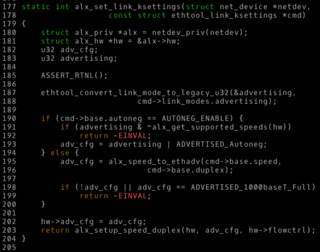PL/I is a procedural, imperative computer programming language initially developed by IBM. It is designed for scientific, engineering, business and system programming. It has been in continuous use by academic, commercial and industrial organizations since it was introduced in the 1960s.

PostgreSQL, also known as Postgres, is a free and open-source relational database management system (RDBMS) emphasizing extensibility and SQL compliance. PostgreSQL features transactions with atomicity, consistency, isolation, durability (ACID) properties, automatically updatable views, materialized views, triggers, foreign keys, and stored procedures. It is supported on all major operating systems, including Linux, FreeBSD, OpenBSD, macOS, and Windows, and handles a range of workloads from single machines to data warehouses or web services with many concurrent users.
In computer science, control flow is the order in which individual statements, instructions or function calls of an imperative program are executed or evaluated. The emphasis on explicit control flow distinguishes an imperative programming language from a declarative programming language.

Ingres Database is a proprietary SQL relational database management system intended to support large commercial and government applications.
A stored procedure is a subroutine available to applications that access a relational database management system (RDBMS). Such procedures are stored in the database data dictionary.
Transact-SQL (T-SQL) is Microsoft's and Sybase's proprietary extension to the SQL used to interact with relational databases. T-SQL expands on the SQL standard to include procedural programming, local variables, various support functions for string processing, date processing, mathematics, etc. and changes to the DELETE and UPDATE statements.
In computer programming, a directive or pragma is a language construct that specifies how a compiler should process its input. Depending on the programming language, directives may or may not be part of the grammar of the language and may vary from compiler to compiler. They can be processed by a preprocessor to specify compiler behavior, or function as a form of in-band parameterization.
A database trigger is procedural code that is automatically executed in response to certain events on a particular table or view in a database. The trigger is mostly used for maintaining the integrity of the information on the database. For example, when a new record is added to the employees table, new records should also be created in the tables of the taxes, vacations and salaries. Triggers can also be used to log historical data, for example to keep track of employees' previous salaries.
A user-defined function (UDF) is a function provided by the user of a program or environment, in a context where the usual assumption is that functions are built into the program or environment. UDFs are usually written for the requirement of its creator.
Harbour is a computer programming language, primarily used to create database/business programs. It is a modernised, open source and cross-platform version of the older Clipper system, which in turn developed from the dBase database market of the 1980s and 1990s.
In computer science, a database cursor is a mechanism that enables traversal over the records in a database. Cursors facilitate subsequent processing in conjunction with the traversal, such as retrieval, addition and removal of database records. The database cursor characteristic of traversal makes cursors akin to the programming language concept of iterator.
SQL Plus is the most basic Oracle Database utility, with a basic command-line interface, commonly used by users, administrators, and programmers.
In ADO.NET, a DataReader is a broad category of objects used to sequentially read data from a data source. DataReaders provide a very efficient way to access data, and can be thought of as a Firehose cursor from ASP Classic, except that no server-side cursor is used. A DataReader parses a Tabular Data Stream from Microsoft SQL Server, and other methods of retrieving data from other sources.
Database activity monitoring is a database security technology for monitoring and analyzing database activity. DAM may combine data from network-based monitoring and native audit information to provide a comprehensive picture of database activity. The data gathered by DAM is used to analyze and report on database activity, support breach investigations, and alert on anomalies. DAM is typically performed continuously and in real-time.
Java Database Connectivity (JDBC) is an application programming interface (API) for the Java programming language which defines how a client may access a database. It is a Java-based data access technology used for Java database connectivity. It is part of the Java Standard Edition platform, from Oracle Corporation. It provides methods to query and update data in a database, and is oriented toward relational databases. A JDBC-to-ODBC bridge enables connections to any ODBC-accessible data source in the Java virtual machine (JVM) host environment.
In computer programming, a function, procedure, method, subroutine, routine, or subprogram is a callable unit of software logic that has a well-defined interface and behavior and can be invoked multiple times.
In database management systems (DBMS), a prepared statement, parameterized statement, or parameterized query is a feature where the database pre-compiles SQL code and stores the results, separating it from data. Benefits of prepared statements are:

Snake case is the naming convention in which each space is replaced with an underscore (_) character, and words are written in lowercase. It is a commonly used naming convention in computing, for example for variable and subroutine names, and for filenames. One study has found that readers can recognize snake case values more quickly than camel case. However, "subjects were trained mainly in the underscore style", so the possibility of bias cannot be eliminated.
Object-PL/SQL is a methodology of using the Oracle Corporation's procedural extension language for SQL and the Oracle relational database. The additional features from version 7 and other improvements, lead to one of the large-scale environment implementations of the object-oriented database paradigm.


